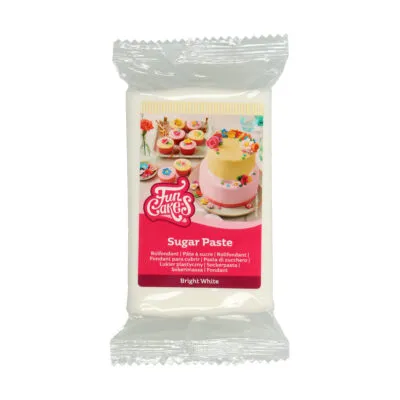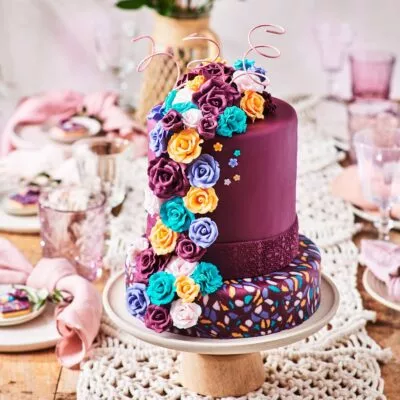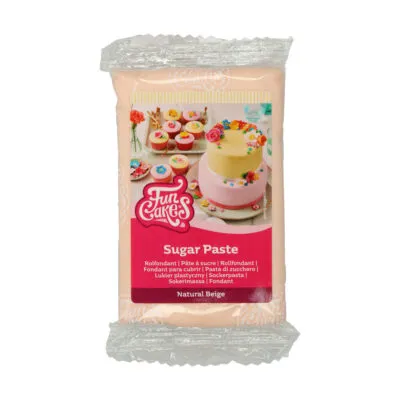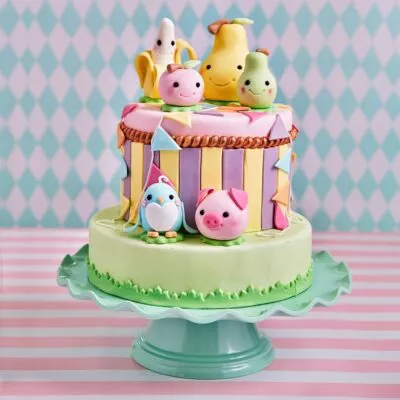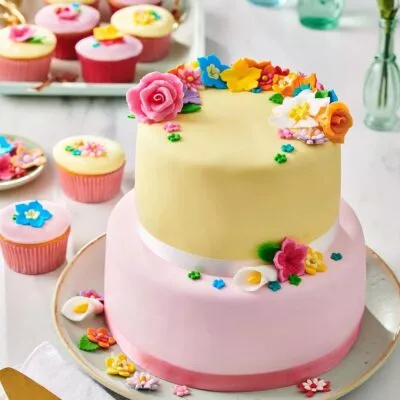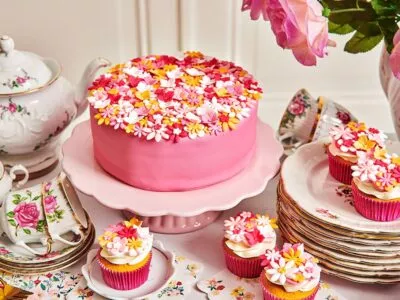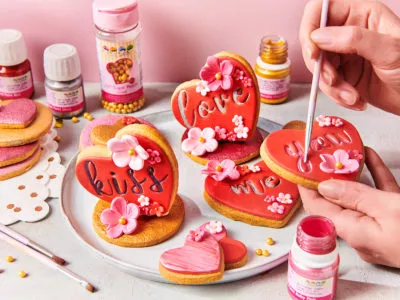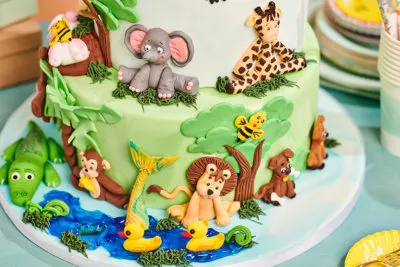Let’s talk about sugar paste
Anyone who wants to make baking not only a tasty, but also a creative hobby, will find lots of joy in working with sugar paste, or fondant. Not only do you give your cakes a nice, colourful layer, but you can also use it to model stylish roses or add it as a layer on your cupcakes or cookies.
You can go a long way with sugar paste, but it’s also a product that you have to get to know and learn how to work with. Sugar paste simply reacts to temperature, the air, your hands and benefits a lot from the right treatment. Feeling, practicing and trying out is key! But once you have found your way of using it, than a whole new world of cake decorating opens up to you and it will bring you that wonderful creative flow that we home bakers love so much.
Do you want to give it a try? In this blog we explain everything about working with sugar paste, from colouring to kneading and covering your cake. We tell you about the FunCakes sugar paste and we share fun recipes to try it with for the first time.
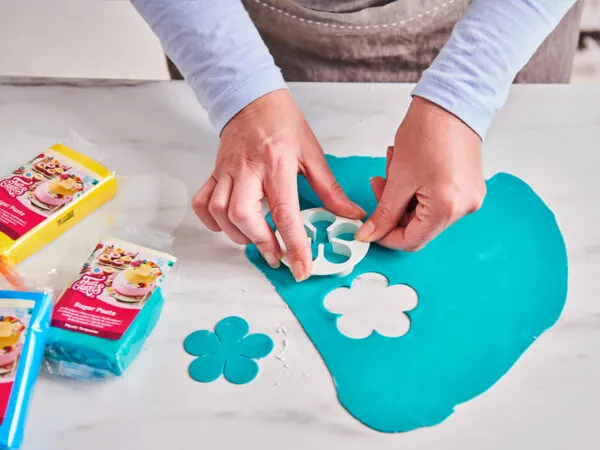
What is sugar paste?
Sugar paste or fondant is a paste that is often used to cover cakes. It has a fine structure and you can knead it very smoothly and elastically, giving your cakes a sleek, almost satin-like look and allowing you to create beautiful detailed decorations. You wouldn’t say, but yes, sugar paste consists almost entirely of… sugar! It has therefore a sweet taste and a white colour. That means you can easily colour it yourself. Or enjoy the convenience of pre-coloured sugar paste!
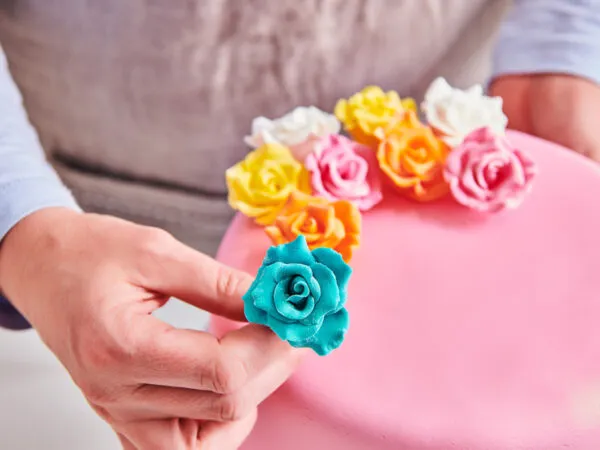
Team Sugar Paste or Team Marzipan?
Sugar paste is often mentioned together with marzipan because they are both sugar pastes with which you cover cakes and model decorations. But, because marzipan also consists of almonds in addition to sugar, it is a lot fatter, has a less fine structure and is not as white as sugar paste. On the other hand, marzipan does not dry out, whereas sugar paste does. We will come back to this later in this blog! It’s a matter of taste, some prefer sugar paste, others marzipan. But if you want that sleek, soft look on your cake and beautifully shaped decorations, then you probably belong to Team Sugar Paste.
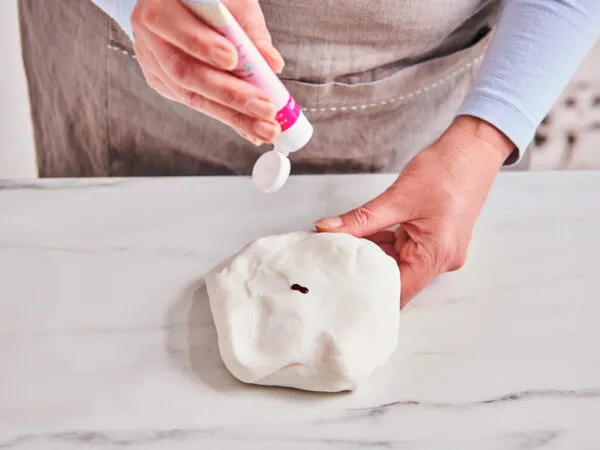
Colouring your sugar paste
There’s a reason we named our white sugar paste Bright White! Sugar paste is super white in colour, which means that it can be coloured perfectly in soft pastel shades as well as happy bright colours. Both the gel and the paste colourings from FunCakes are suitable for this. If you are looking for a soft shade, start with a single drop, knead well and see if you like the colour. Add extra drops if you like a deeper or brighter colour. Experiment until you have reached the right shade! Knead well each time until the colouring has completely spread over your white sugar paste. Or knead half way through if you like a cool marble effect.
Do you find it too much of a hassle to colour your sugar paste yourself? You’re not the only one. FunCakes therefore has 40 colours of sugar paste in its range. You can also mix the coloured sugar paste together to get new colours! So for light pink sugar paste knead a piece of Bright White through our Hot Pink sugar paste.
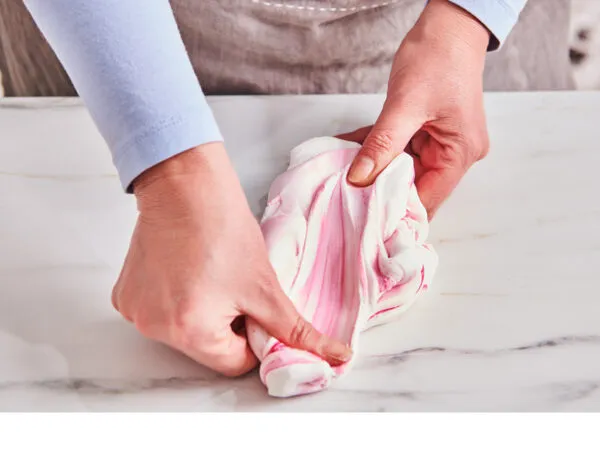
Colouring fondant red and black
Unfortunately, the fact that sugar paste is so beautifully white also has a downside. Very deep, dark colours can sometimes be a bit tricky to create yourself. Deep black or bright red are the most difficult colours to make yourself from white sugar paste. Those who work a lot with these colours often choose to buy them pre-coloured. But FunCakes wouldn’t be FunCakes if we wouldn’t have some tips to make these colours yourself.
Food colourings will keep on developing into your sugar paste even after you’ve kneaded it all the way through. To achieve a deeper colour, it’s therefore good to let the sugar paste rest for a while before you start working with it. When colouring black and red sugar paste, we recommend you do so overnight. This gives the food colouring more chance to develop properly. Very important though: sugar paste dries out quickly, so always make sure you wrap your sugar paste well in plastic foil and knead it completely smooth again the next day before you start using it.
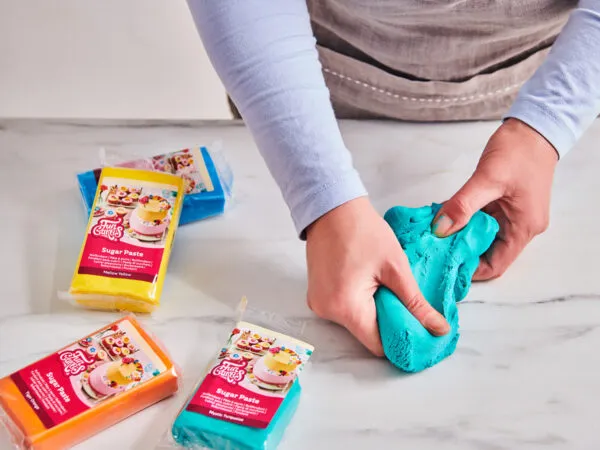
Kneading sugar paste
Do you want nice tight corners on your sugar paste cake or tight edges on your cut sugar paste figures, then this is the most important job: kneading your sugar paste. When kneading your sugar paste you develop its elasticity and that will help you later in the process. So make sure your sugar paste is always smooth before rolling it out, but don’t overdo it! Kneading endlessly can also make your sugar paste too soft and the warmth of your hands can make the sugar paste feel sticky and sweaty. Nicely smooth and elastic is what you want to achieve, then immediately continue rolling out. When rolling out, do you notice that cracks appear at the edges? That’s a sign that you haven’t kneaded sufficiently. Knead the sugar paste a bit more until these cracks are no longer visible. Even if you have coloured your sugar paste or if you put it aside for a while, we always recommend you knead it again before processing it.
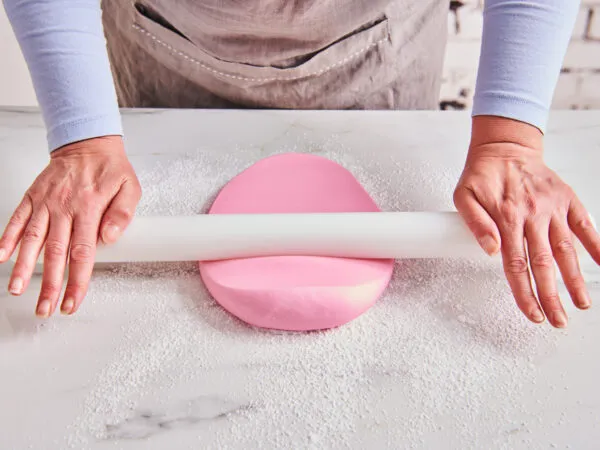
Covering your cake
To cover your cake with sugar paste, roll it out into an even circle. Keep a thickness of 2-3mm to be able to cover your cake nicely. As with dough, sugar paste will stick to the surface, so always make sure you have dusted your counter with icing sugar or Magic Roll-Out Powder. These are both very fine powders that won’t affect the texture of your sugar paste, but make sure you don’t overdo it with the amount of powder. Too much powder can dry out your sugar paste and cause it to crack again. You also prevent it from sticking to the surface by turning your piece of sugar paste a quarter turn every now and then in between rolling out.
To cover a cake tightly, the sponge cake is just as important. Imperfections in the sponge cake remain visible even with a layer of sugar paste over it. It is therefore best to cover your cake with a thin layer of buttercream and put it in the fridge for an hour before covering it with sugar paste. The buttercream will then harden and form a nice tight surface for your sugar paste. Never cover your sponge cake with water-based creams, such as whipped cream or Enchanted Cream®. The sugar from the sugar paste will react to the water causing the sugar paste to ‘melt’ and not stick properly to your cake.
Using side scrapers and your hands, apply the sugar paste tightly around your cake and cut off the excess sugar paste with a plastic knife. We’ll show you exactly how this works in the video below!

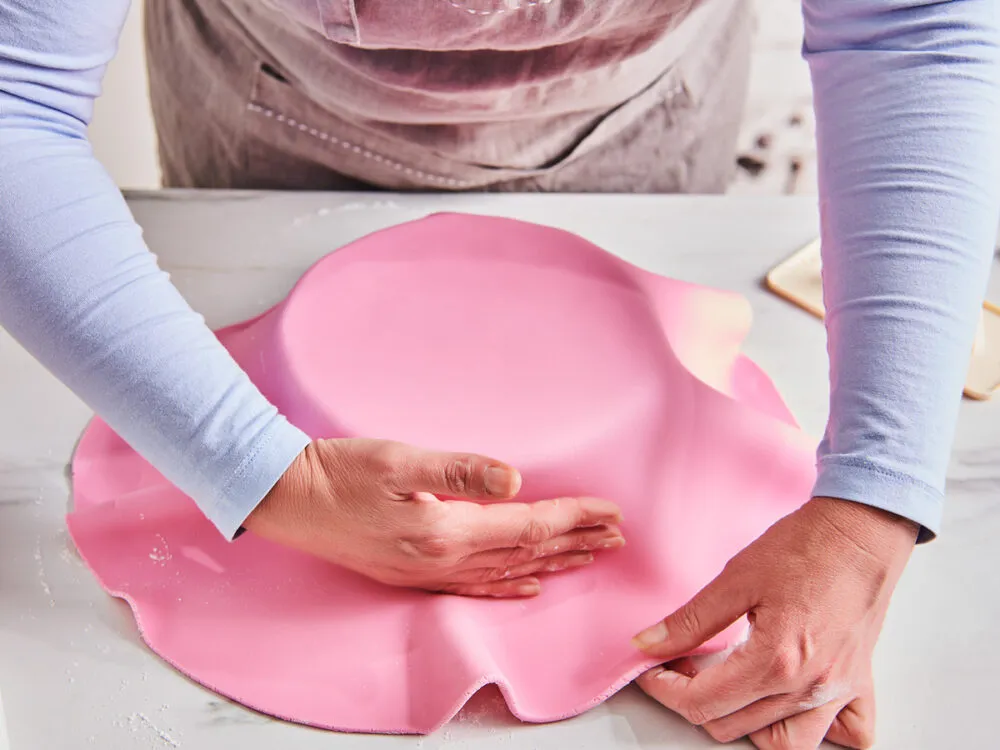
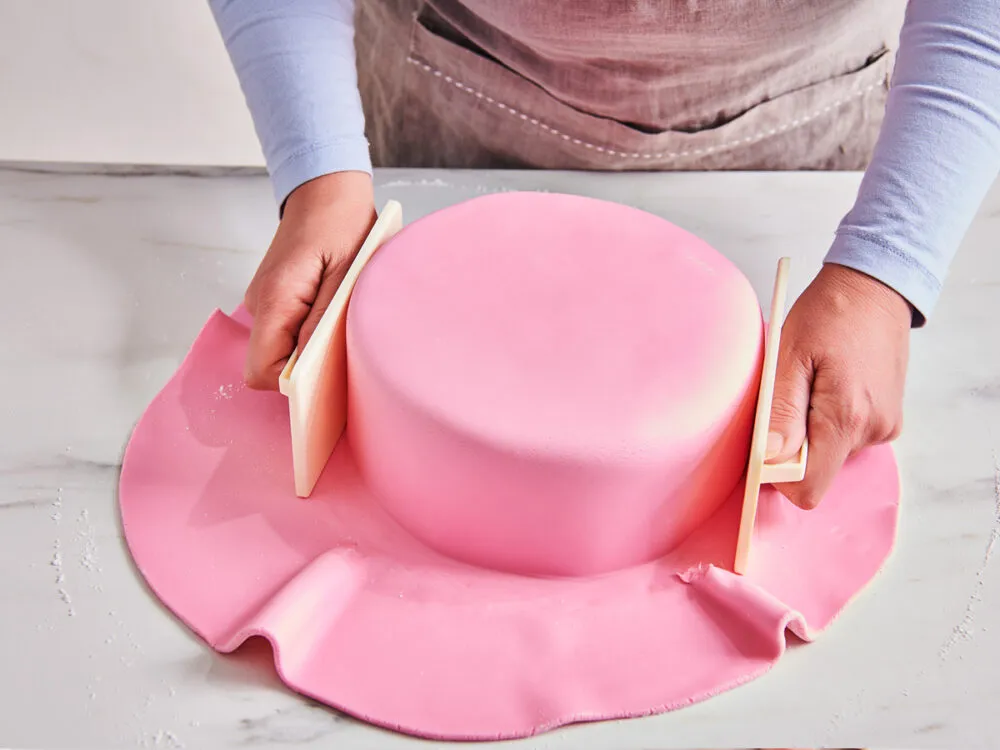
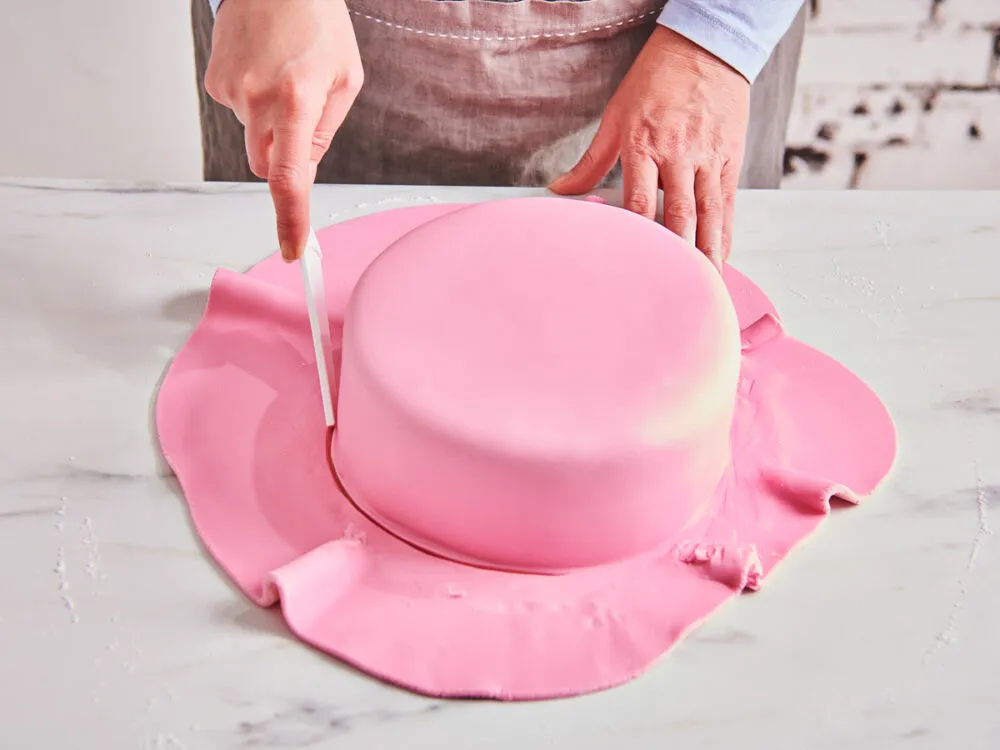
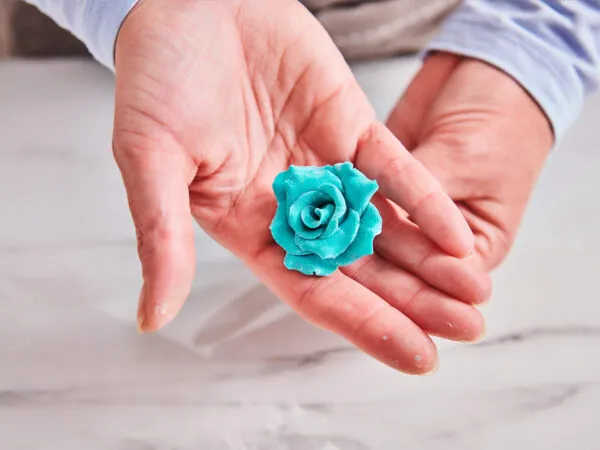
Sugar paste can dry out
What sometimes makes working with sugar paste more difficult, but at the same time is a plus, is that it dries out when it comes into contact with air. So if you leave a piece of sugar paste on a counter for hours without covering it in plastic, you can be sure to having to throw it away afterwards.
It dries out rather quickly, so some speed is important when covering your cake. Drinking a cup of coffee between rolling out your sugar paste and covering your cake is therefore not necessarily a good idea. Nothing to deter you, but something to be aware of when making a sugar paste cake.
This also has a big advantage. Sugar paste therefore also retains the shape in which you have brought it. So if you have made beautiful sugar paste decorations, you can be sure that you will not suddenly find them collapsed on your cake. And if you managed to cover that cake perfectly tight, it will stay that way.
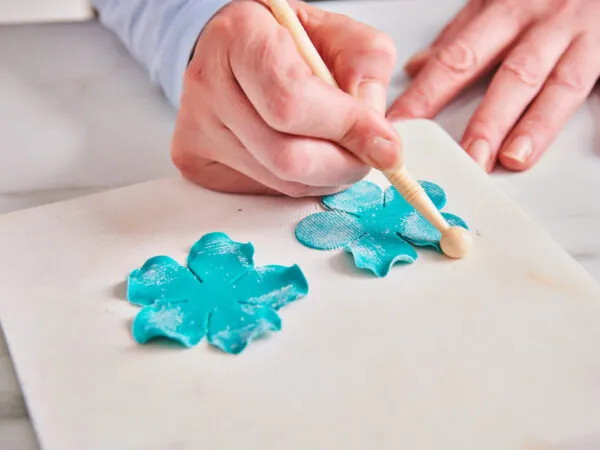
Speaking of decorations
Covering your cake with sugar paste is nice, but how to use it when making decorations? All the above tips also apply when making decorations, so it is again important to knead well and to always sprinkle the surface with icing sugar or Magic Roll-Out Powder. FunCakes sugar paste can be used to make basic decorations such as simple flowers or figures. If you like to work in a more detailed and refined way, then you will end up with modelling or gum paste. These pastes are even stronger than sugar paste, so you can make much thinner and smaller parts without them breaking or tearing.
But you are perfectly fine making a rose or other flowers with sugar paste! So let your creativity run wild and spend an afternoon modelling. Do you indeed notice that the sugar paste remains a little too soft for certain decorations? Then you can mix it with a little bit of CMC-tylo powder. As a result, it dries out faster, making it a bit stiffer and also retains its shape quickly.
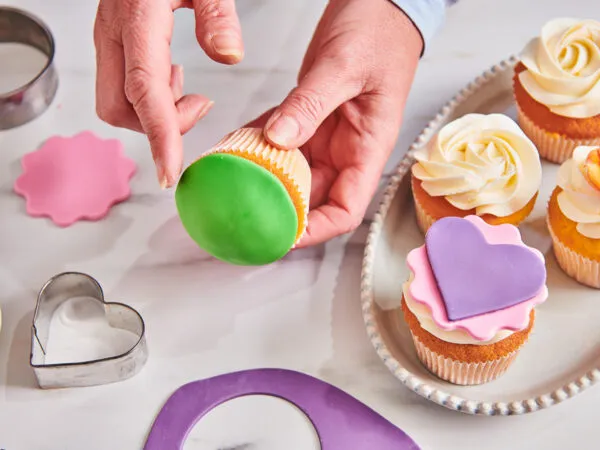
FunCakes sugar paste
FunCakes has a huge range of sugar paste consisting of many, many different colours. But in our range you will also find flavoured sugar paste, multipacks of sugar paste or ready rolled sugar paste discs (you place them directly on your cake without kneading and rolling it out!). In addition to the 250 g packs, our most popular colours are also available in 1 kg and our white sugar paste is even available in 5 and 10 kg!
Sugar paste is one of the most personal products in the cake decorating world. It is possible that your neighbor swears by a sugar paste that you can not work with at all. Some like to work with a stiffer sugar paste and others with a softer version. And the temperature in your home or from your hands also has an effect on the sugar paste. Nevertheless, we found it important to develop a sugar paste that works well for as many home bakers as possible. And so we did!
FunCakes sugar paste is easy to knead, so you can quickly activate the elasticity and get started with it. Because it is nice and flexible, it rolls out easily, but you can also mold nice decorations with it. That’s why we call it a forgiving sugar paste! The less experienced sugar paste user can also handle FunCakes well. Because we want everyone to be able to make such a beautiful sugar paste cake!

Try our Sugar Paste Colour of the Year
In addition to FunCakes’ normal range of sugar paste, there is now also the Sugar Paste Colour of the Year. Every year we release a new trend colour for the coming year. For 2024, the Sugar Paste Colour of the Year is Chic Aubergine! It is a warm, luxurious and quirky colour. The deep tones of Chic Aubergine make us feel comfortable, loved and cozy. Cakes and other treats decorated with this colour will get a unique and classy look.
Honey Gold can be combined with the 4 supporting colours: Rosé White, Vintage Purple, Mystic Turquoise and Tropical Orange.
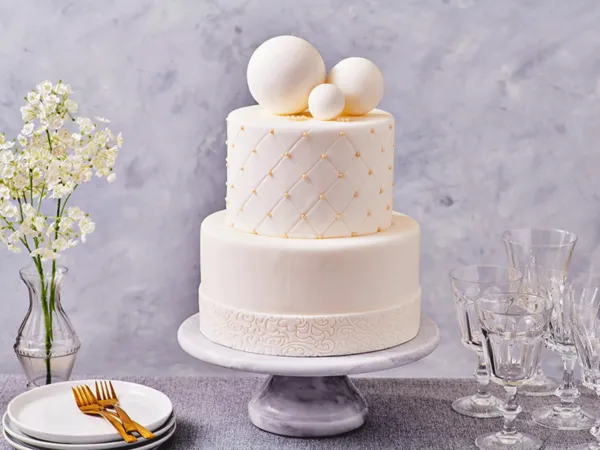
FunCakes Covering Paste
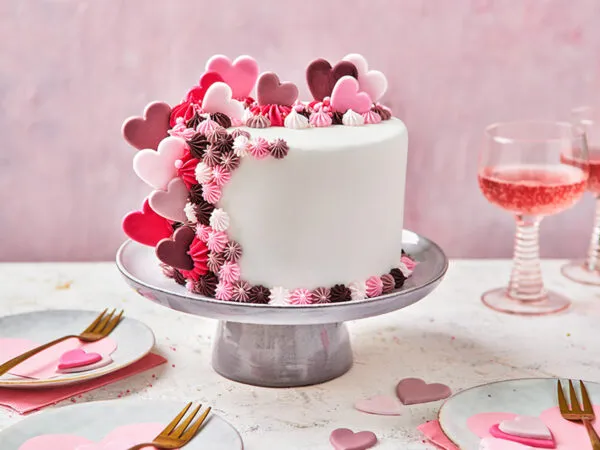
Why this new type of sugar paste?
Sugar paste is one of the most so-called subjective products there is in cake decorating. Some like it a bit softer, whereas other’s like it firm. It’s a product that reacts on temperature of the room, of somebody’s hands. And working with it isn’t an easy task and takes some time to get skilled in.
It is our goal to make high quality products that are easy to use for any baking fan, whether you’re a beginner or a (semi-)professional. Our existing sugar paste is therefore a soft, easy-to-knead, forgiving sugar paste. But we know some people prefer a firmer fondant. And cause we’re here for all those bakers we decided to develop a second option.
The new FunCakes covering paste is extremely flexible and easy to roll out under 2mm. This helps you creating perfect, straight edges, even when making taller and bigger cakes.
Beginners will love how easy to use this covering paste is. After kneading, the sugar paste is very elastic and flexible which will help also the less experienced home baker. Professionals will work even quicker and more cost effective thanks to the great workability.







